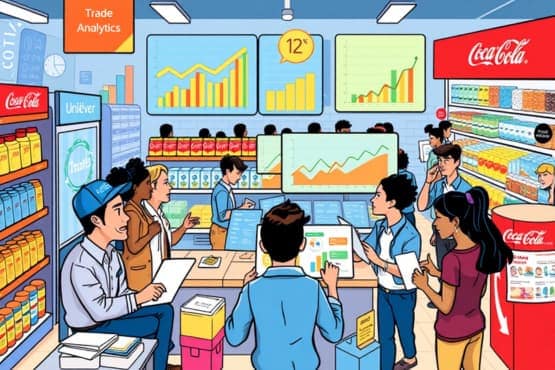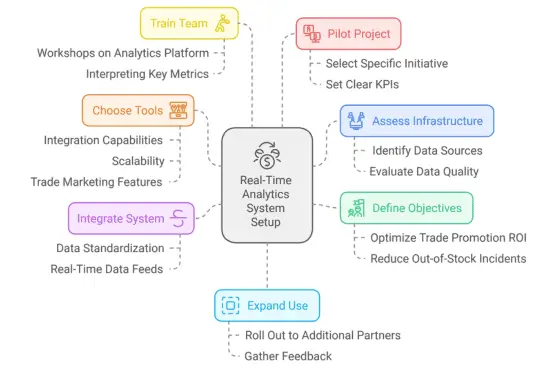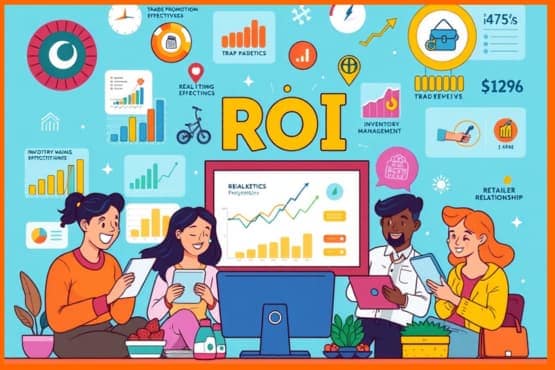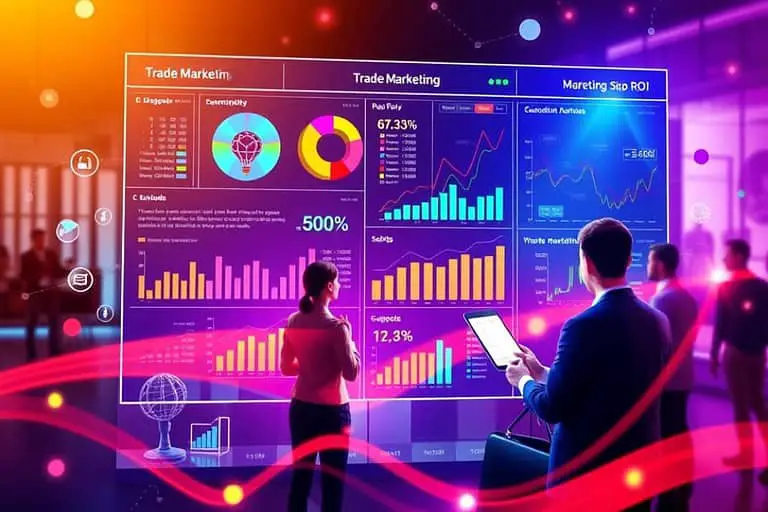Real-time trade data has become a game-changer for trade marketers. It provides up-to-the-minute information on market trends, retailer behaviour, and promotional performance.
Trade marketers who use this data can react swiftly to changes in the retail landscape. They can adjust their strategies on the fly, giving them a significant edge in managing relationships with retailers and distributors. This agility is vital in trade marketing, where timing can make or break a promotion or product launch.
Many companies struggle with slow decision-making processes and outdated information about their trade channels. Real-time analytics addresses these issues head-on. It offers a solution to common trade marketing challenges like:
- Coordinating promotions across multiple retailers
- Managing inventory flow through various distribution channels
- Responding to shifting retailer behaviours and preferences
- Optimizing trade spending in real-time
By leveraging real-time data, trade marketers can move from reactive to proactive strategies, ensuring they stay ahead in a competitive retail environment.
Key Takeaways
- Real-time trade data enables faster, more informed decisions in trade marketing
- Instant insights boost B2B engagement and optimize trade promotions
- Implementing real-time analytics faces challenges but offers significant ROI in trade channels
- Choosing the right tools and building a data-driven culture is crucial for trade marketing success
- Real-time analytics provide a long-term competitive edge through adaptive pricing and quicker go-to-market strategies
2. Benefits of Real-Time Analytics in Trade Marketing
Enhanced Decision-Making Capabilities
Real-time data transforms how trade marketers make choices. They can make informed decisions quickly with instant updates on stock levels, promotional performance, and retailer actions.
For example, Procter & Gamble uses real-time analytics to track the performance of its trade promotions across different retailers.
This system allows them to adjust promotional strategies on the fly, reallocate trade spending to high-performing channels, and avoid overspending on ineffective promotions.
As a result, they’ve seen improved ROI on their trade marketing investments and stronger relationships with key retail partners.
Improved B2B Engagement and Personalization
Real-time insights allow trade marketers to tailor their approach to individual retail partners. They can respond to changing preferences, creating more personalized and effective trade marketing programs.
Unilever excels at this in its trade marketing efforts. Their real-time analytics platform allows them to segment retailers based on real-time performance data and tailor trade promotions accordingly.
This personalized approach has significantly boosted their sell-through rates and strengthened their position with key retail accounts.

Increased Operational Efficiency and Agility
Real-time analytics helps trade marketers track key performance indicators (KPIs) more effectively. They can monitor sell-in rates, promotion effectiveness, and inventory levels as events unfold across their trade channels.
Coca-Cola uses real-time data to optimize its distribution and trade marketing operations. By tracking sales and inventory in real-time across their vast network of retailers and distributors, they can adjust production schedules, reallocate inventory, and fine-tune trade promotions to match local market conditions.
This agility has reduced waste, improved product availability, and more effective use of trade marketing budgets.
3. Opportunities in Trade Marketing
Leveraging Data for Competitive Advantage
Real-time analytics opens up new possibilities for trade marketers. They can implement dynamic pricing strategies, manage inventory more effectively across multiple retail partners, and adjust trade promotions rapidly based on real-time market feedback.

Nestlé uses real-time data to optimize its trade promotions across different retail channels. Their system allows them to:
- Adjust promotional pricing in real time based on competitor actions and local market conditions
- Reallocate trade spending to high-performing retailers or products during a promotion
- Predict and prevent stockouts by adjusting inventory distribution in real-time
- Provide retailers with instant insights on promotion performance, strengthening partnerships
This approach has significantly increased the effectiveness of their trade spend and improved relationships with key retail partners.
Case Studies
Kimberly-Clark has successfully used real-time analytics to transform its trade marketing approach. By implementing a real-time trade promotion optimization platform, they were able to:
- Reduce the time needed to plan and execute trade promotions by 50%
- Increase the ROI of their trade spend by 20%
- Improve forecast accuracy for promotional volumes by 30%
The platform allows them to simulate different promotional scenarios in real time, adjust trade investments on the fly, and provide instant feedback to retail partners on promotion performance.
This has improved their trade marketing effectiveness and strengthened their position as a preferred supplier to major retailers.
Future Trends and Innovations
The role of artificial intelligence in real-time trade analytics is growing rapidly. AI can process vast amounts of data from multiple retail partners and distribution channels, spotting patterns and making predictions that humans might miss.
Predictive analytics is becoming increasingly crucial in trade marketing. It allows trade marketers to:
- Anticipate changes in retailer demand and adjust trade strategies proactively
- Predict the impact of different trade promotion scenarios across various retail partners
- Optimize trade spend allocation across different products, channels, and regions
- Automate routine trade marketing tasks, allowing teams to focus on strategic initiatives
As these technologies evolve, trade marketers who embrace real-time analytics will be well-positioned to outperform their competitors and drive sustainable growth through their trade channels.
4. Challenges in Implementation
Data Integration Complexities
One of the biggest hurdles in implementing real-time analytics for trade marketing is integrating data from various sources. Trade marketers often work with multiple retail partners, distributors, and sales channels, each with their own data systems and formats.

For instance, when Unilever implemented its real-time trade marketing platform, it faced the challenge of integrating data from:
- Multiple retailer point-of-sale systems
- Their own ERP and CRM systems
- Third-party market data providers
- Field sales team reports
- Social media and consumer sentiment data
To overcome this, they invested in a robust data integration platform that could standardize and harmonize data from these diverse sources in real time.
While the initial implementation was complex, the resulting insights have greatly improved their trade marketing effectiveness and retailer relationships.
Privacy and Security Concerns
Handling trade partner data across diverse retail platforms raises essential privacy and security issues. Trade marketers must comply with regulations like GDPR and CCPA while leveraging real-time data power.
In the B2B context of trade marketing, privacy concerns often revolve around protecting the sensitive business information of retail partners. Trade marketers need to:
- Implement robust data encryption and access control measures
- Clearly define data usage policies with retail partners
- Ensure compliance with industry-specific regulations (e.g., in pharmaceuticals or financial services)
- Regularly audit data handling practices to maintain trust with trade partners
Resistance to Change Within Organizations
Implementing real-time analytics often requires significant changes to established trade marketing processes. This can lead to resistance from employees who are comfortable with existing methods.
When Kraft Heinz introduced real-time analytics to optimize their trade promotion management, they faced initial resistance from their sales and trade marketing teams. To overcome this, they:
- Conducted extensive training programs to help staff understand the benefits of real-time analytics
- Started with a pilot program in one region to demonstrate success before rolling out company-wide
- Involved key stakeholders in the selection and implementation of the analytics platform
- Celebrated early wins to build momentum and buy-in across the organization
By taking this approach, they were able to successfully transform their trade marketing practices and achieve significant improvements in trade spend efficiency.
5. Tools and Technologies
Popular Analytics Platforms for Trade Marketing
There are many tools available for real-time analytics in trade marketing, each suited to different needs:

- For small to medium-sized businesses:
- Nielsen Retail Execution: Offers real-time insights on in-store performance
- Salesforce Consumer Goods Cloud: Provides real-time data on retail execution and trade promotion management
- For large enterprises:
- SAP Trade Management: Comprehensive solution for end-to-end trade promotion management
- Oracle Retail: Offers advanced analytics for retail execution and trade promotion optimization
Comparison of Trade Marketing Analytics Tools
| Tool | Best For | Key Features | Integration Capabilities |
|---|---|---|---|
| Nielsen Retail Execution | Field sales teams | Real-time store audits, Image recognition | Easy integration with major ERP systems |
| Salesforce Consumer Goods Cloud | Multi-channel trade marketing | Trade promotion management, Retail execution | Native integration with Salesforce CRM |
| SAP Trade Management | Large CPG companies | End-to-end trade promotion management, AI-powered optimization | Deep integration with SAP ERP and other modules |
| Oracle Retail | Retailers and CPG companies | Advanced demand forecasting, Trade promotion optimization | Seamless integration with Oracle E-Business Suite |
Best Practices for Selecting the Right Technology
When choosing a real-time analytics tool for trade marketing, consider:
- Integration capabilities: Ensure the tool can easily connect with your existing CRM, ERP, and data warehouse systems.
- Scalability: Choose a platform that can grow with your business and handle increasing data volumes.
- Customization: Look for tools to tailor reports and dashboards to your specific trade marketing KPIs.
- Mobile accessibility: Ensure the platform offers robust mobile capabilities for field sales teams.
- AI and predictive capabilities: Consider tools that offer advanced features like AI-powered promotion optimization and demand forecasting.
- Vendor support and community: Evaluate the level of support the vendor offers and the user community’s strength.
By carefully assessing these factors, you can select a tool that meets your current trade marketing needs and supports your future growth and innovation.
6. Strategies for Success
Setting Up a Real-Time Analytics System in Trade Marketing

- Assess your current trade marketing data infrastructure:
- Identify all data sources (e.g., POS data, inventory systems, CRM)
- Evaluate the quality and accessibility of your data
- Define clear objectives for your real-time analytics implementation:
- Example: “Optimize trade promotion ROI by 15% within 6 months”
- Example: “Reduce out-of-stock incidents by 25% across key retail partners”
- Choose the right tools based on your needs and budget:
- Consider factors like integration capabilities, scalability, and specific trade marketing features
- Integrate the new system with existing data sources:
- Implement data standardization processes
- Set up real-time data feeds from retail partners
- Train your team on how to use and interpret real-time trade marketing data:
- Conduct workshops on using the new analytics platform
- Guide interpreting key trade marketing metrics in real-time
- Start with a pilot project to test and refine your approach:
- Select a specific trade marketing initiative or retail partner for the pilot
- Set clear KPIs to measure the impact of real-time analytics
- Gradually expand the use of real-time analytics across your trade marketing operations:
- Roll out to additional retail partners or trade marketing initiatives
- Continuously gather feedback and refine your approach
Building a Data-Driven Culture in Trade Marketing
Creating a data-driven culture is crucial for the success of real-time analytics in trade marketing.

Here’s how to foster this culture:
- Lead by example: Ensure leadership uses real-time data in decision-making and communications
- Provide ongoing training: Offer regular workshops on data interpretation and analytics tools
- Encourage cross-functional collaboration: Foster teamwork between sales, trade marketing, and analytics teams
- Celebrate data-driven successes: Highlight wins achieved through real-time analytics to motivate the team
- Implement data-driven KPIs: Align performance metrics with real-time data usage and outcomes
- Create a feedback loop: Regularly gather input from users to improve analytics tools and processes
PepsiCo has successfully built a data-driven culture in its trade marketing department. They’ve invested in training programs to help marketers effectively understand and use real-time data. This has led to more targeted and successful trade marketing campaigns, with improvements in:
- Trade promotion effectiveness
- Retailer relationship management
- New product launch success rates
- Overall trade marketing ROI
Measuring ROI from Real-Time Analytics in Trade Marketing

To measure the return on investment from real-time analytics, track metrics such as:
- Trade Promotion Effectiveness:
- Promotional uplift
- Incremental sales generated
- ROI per promotion
- Inventory Management:
- Reduction in out-of-stock incidents
- Improvement in inventory turnover
- Decrease in obsolete inventory
- Retailer Relationship Metrics:
- Retailer satisfaction scores
- Share of shelf space
- Number of new product listings
- Operational Efficiency:
- Reduction in trade promotion planning time
- Increase in field sales team productivity
- Decrease in trade spend waste
- Overall Financial Impact:
- Increase in net sales through trade channels
- Improvement in trade marketing ROI
- Growth in market share
Compare these metrics before and after implementing real-time analytics to gauge their impact on your trade marketing performance.
Regular benchmarking against industry standards can also help you understand the competitive advantage gained through real-time analytics.
7. Final Thoughts
Real-time trade stats offer huge chances to boost returns in trade marketing. By giving quick insights into store actions, promo success, and market shifts, it lets trade marketers create smarter more flexible plans.
Still, putting real-time analytics into action in trade marketing has its share of hurdles. It calls for careful planning, proper tools, and changing the organization’s thoughts.
However, for companies that manage to overcome these obstacles, the payoffs can be huge – from better use of trade spending to improved ties with retailers and a bigger slice of the market.
To master real-time analytics for trade marketing success, explore our comprehensive resources at Trade Marketing Insider.




